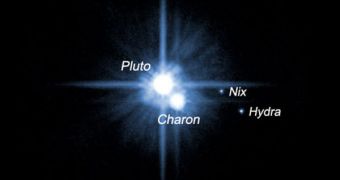Exactly five years ago today, astronomers at the Boulder, Colorado-based Southwest Research Institute (SwRI) decided on what to call two of Pluto's moons, that were discovered barely a year before. After nearly 12 months on debates about possible names, the team decided on Hydra and Nix.
Both of these diminutive space rocks orbit the dwarf planet Pluto, which is located in the Kuiper Belt. For years, astronomers have considered Pluto to be a fully-fledged planet, but a few years ago some astronomers decided to reclassify it.
Regardless of whether the body is a planet or not, the fact remains that it has three moons, the larger Charon, and the smaller Nix and Hydra. The latter two were found in June 2005, and finally got their names on June 21, 2006.
Nix was named after the Greek goddess of darkness and night, who was also the mother of Charon. The object is believed to be less than 50 miles (80 kilometers) in diameter, although there is no clear way for astronomers to establish that for certain.
Both Nix and Hydra are so small and far away that it's literally impossible to assess their actual sizes, densities and diameters using today's technologies. But the NASA New Horizons spacecraft is on its way to the system, scheduled to begin its observations in 2015.
What astronomers do know is that Hydra is slightly brighter than Nix when viewed from our vantage point. This means that the former is slightly larger, but by how much is still a matter of debate.
Both objects are located between 4.2 and 7.5 billion kilometers away from Earth, the equivalent of 2.6 to 4.7 billion miles. This makes them little more than specs on even the most advanced detectors we have today, Space reports.
Understanding how the two moons formed is a very complex challenge, but astronomers seem to agree that Pluto was impacted by other objects early on in the history of the solar system, leading to the creation of its three companions.
“If all three satellites presumably formed from the same material lofted into orbit around Pluto from a giant impact, you might well expect the surfaces of all three satellites to have similar colors,” Alan Stern, the leader of the SwRI group, said in 2006.
Subsequent observations have revealed that this is indeed the case. The moons were also found to be covered in water and ice, meaning that they reflect light back with the same intensity across all wavelengths.

 14 DAY TRIAL //
14 DAY TRIAL //